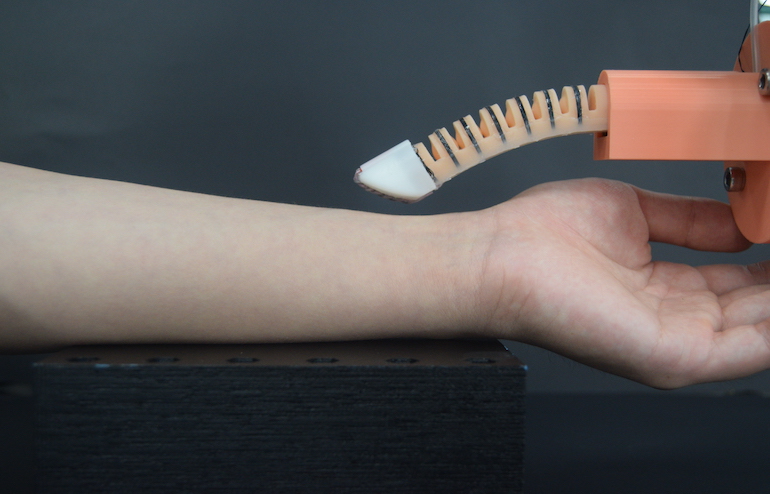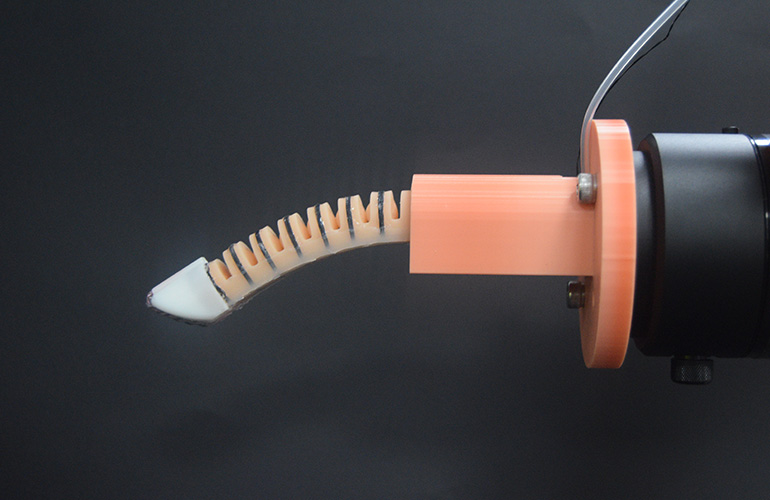The researchers’ robotic finger contains conductive fiber coils and a twisted liquid-metal fiber at the fingertip. | Source: Hongbo Wang
Researchers at the University of Science and Technology of China said they have developed a soft robotic “finger” with a sense of touch that can perform routine doctor office examinations, including taking a patient’s pulse and checking for abnormal lumps.
The scientists said this technology could make it easier for doctors to detect diseases like breast cancer early, when they are more treatable. It could also put patients at ease during physical exams that can seem uncomfortable and invasive.
“By further development to improve its efficiency, we also believe that a dexterous hand made of such fingers can act as a ‘Robodoctor’ in a future hospital, like a physician,” stated Hongbo Wang, a sensing technologies researcher at the University of Science and Technology of China and an author of the study.
“Combined with machine learning, automatic robotic examination and diagnosis can be achieved, particularly beneficial for these undeveloped areas where there is a serious shortage in health workers,” he said.
Robotic finger is delicate enough for human contact
While rigid robotic fingers already exist, experts have raised concerns that these devices might not be up to the delicate tasks required in a doctor’s office setting. Some have pointed to potential safety issues, including a fear that overzealous robotic fingers could rupture lumps during examinations.
More recently, scientists have developed lightweight, safe, and low-cost soft robotics that can recreate the movements of human hands. However, these devices typically haven’t been able to sense the complex properties of objects they touch the way real fingers do.
“Despite the remarkable progress in the last decade, most soft fingers presented in the literature still have substantial gaps compared to human hands,” the authors wrote. By contrast, robotic fingers have not been ready to handle real-world scenarios, they said.
To overcome this challenge, the University of Science and Technology of China developed a simple device that contains conductive fiber coils with two parts. One is a coil wound on each air chamber of the device’s bending actuators, and the other is a twisted liquid metal fiber mounted at the fingertip. This way, the device could perceive an object’s properties as effectively as human touch.

The robotic finger is designed to be soft and sensitive enough for medical diagnosis. Source: Hongbo Wang
Researchers put soft finger to the test
To test the device, the researchers started by brushing a feather against its fingertip.
“The magnified view clearly shows the resistance change, indicating its high sensitivity in force sensing,” the authors wrote.
Next, they tapped and pushed the fingertip with a glass rod and repeatedly bent the finger, observing that the device’s sensors accurately perceived the type and quantity of force they applied.
To test the finger’s medical chops, they mounted it on a robotic arm and watched as it identified three lumps embedded in a large silicone sheet, pressing on them like a doctor would. While mounted on the robotic arm, the finger also correctly located an artery on a participant’s wrist and took their pulse.
“Humans can easily recognize the stiffness of diverse objects by simply pressing it with their finger,” said the researchers. “Similarly, since the [device] has the ability to sense both its bending deformation and the force at the fingertip, it can detect stiffness similar to our human hand by simply pressing an object.”
In addition to taking pulses and examining simulated lumps, the researchers found that the robotic finger can type “like a human hand,” spelling out the word “hello.”
Additional sensors provide even more flexibility in the robotic finger’s joints. They allow the device to move in multiple directions like a human finger, so it may be ready to perform effective and efficient medical examinations in the near future, the team concluded.
“We hope to develop an intelligent, dexterous hand, together with a sensorized artificial muscle-driven robotic arm, to mimic the unparalleled functions and fine manipulations of the human hands,” said Wang.
This work was published in the Cell Press journal Cell Reports Physical Science.

 1 month ago
17
1 month ago
17










 English (US) ·
English (US) ·